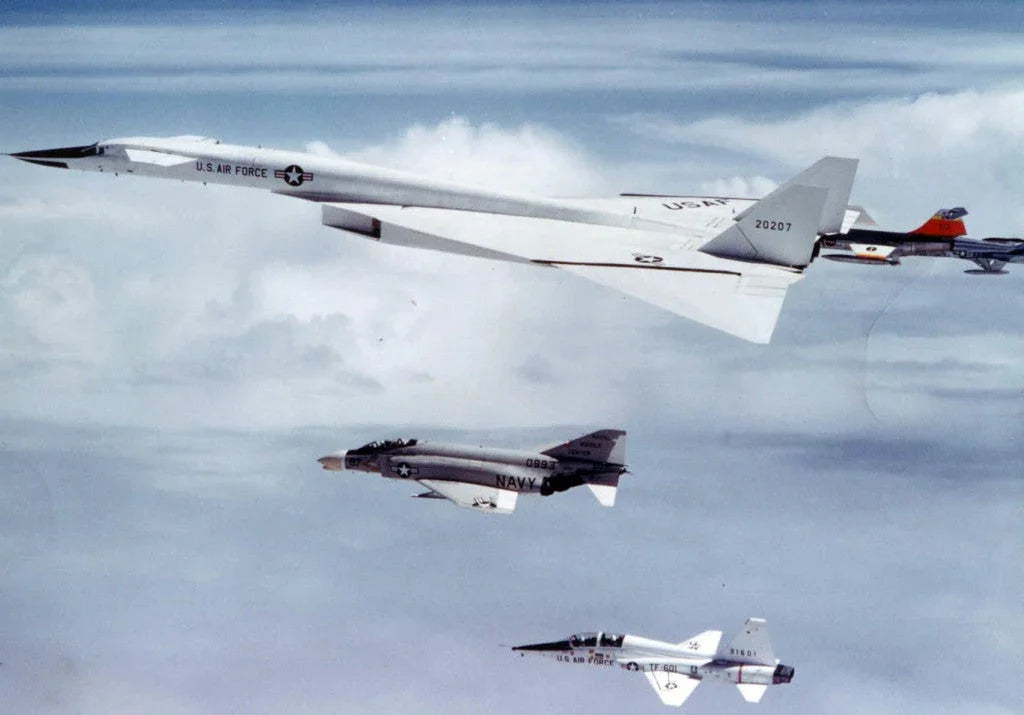Alvin Swauger White, North American Aviation Test Pilot
Last week I wrote a blog post about the accident resulting in the demise of the North American Aviation XB-70 Valkyrie aircraft.
Today we take a look at one of the pilots, the pilot in command of the XB-70 Vlakyrie on that fateful day.
His name is Alvin Swauger White, an American test pilot and mechanical engineer.
He flew the original flights on both XB-70 Valkyrie aircraft, piloting the first aircraft to 2,000 mph, and all subsequent Mach 3 exploration flights.

A test pilot is an aircraft pilot with specialized training to fly and evaluate new and experimental aircraft by flying a set of specific maneuvers known as flight test techniques.
There are a number of test pilot schools, including the oldest test pilot school at RAF Boscombe Down in the UK. There are a number of other test pilot schools all over the world.
The one most of us are familiar with is the USAF Test Pilot School located at Edwards Air Force Base in California.
Biography
Alvin S. White was born on December 9, 1918, in Berkley, CA. After he graduated from high school in 1936, he enrolled at the University of California at David to study electrical engineering.
Two years later, he transferred to the campus in Berkley. He then decided to enter the Civilian Pilot Training Program to become a pilot, which he did in 1940.
When World War II came along, Al White enrolled in the US Army Air Force as an aviation cadet. He completed his training at Williams Field, AZ, in 1942.
He then became a P-51 pilot, flying escort for B-17 bombers over Germany and performing strafing missions throughout Europe.
He entered the European theater on D-Day and continued flying over Europe until V-E Day (Victory in Europe).

A North American P-51D Mustang fighter aircraft from the 375th Fighter Squadron in flight.
The North American P-51
Early on in the Second World War, the British urgently requested a low-altitude fighter that could also be used for reconnaissance.
North American Aviation in the US designed, built, and began production with an Allison V-1710 engine and a highly effective laminar wing design.
P-51s were manufactured in Dallas, Texas, and the airplane had the soul of a racer.
Specifications of the P-51D:
- Maximum Takeoff Weight: 11,600 pounds
- Wingspan: 37 feet 1 inch
- Fuesalage Length: 32 feet 3 inches
- Height: 13 feet 8 inches
- Maximum Speed: 437 mph
- Rate of Climb: 3,200 feet per minute
- Range: 950 miles
- Service Ceiling: 41,900 feet
- Power Plant: 1,695 hp V-12 Packard Merlin V1650-7 liquid-cooled engine
- Armament: Siz 0.50 caliber machine guns with provision to carry two 500-pound bombs
Post War Experience
Upon the conclusion of the Second World War, Al White finished his Bachelor's Degree in Mechanical Engineering at UC Berkley, and he went on to become an engineering test pilot for the US Air Force and North American Aviation.
Among the many aircraft flight testing assignments, Al White test flew the F-86 Sabre Jet, the F-100 Super Sabre series, the original YF-107, and then the X-15.
Al White was chosen for the U.S. Air Force's "Man In Space Soonest" manned spaceflight program. However, the program ended early due to financial and technical difficulties.
In 1961 Al White was chosen to be the Chief Test Pilot for the XB-70 Valkyrie flight test program, the world's largest supersonic aircraft.
Al took the aircraft through the buildup programs reaching Mach 3 in flight.

Al White going over flight details standing in front of the XB-70 preparing for a test flight.
On June 8, 1966, he and his co-pilot, Major Carl Cross, USAF, were piloting the XB-70 when it collided when Joe Walker, flying a NASA F-104N aircraft, collided with the right-wing droop tip leading to his death and the destruction of the XB-70.
Al White successfully escaped the XB-70 in his escape capsule but suffered one arm crushed when it was caught in the clamshell doors of the escape capsule. He received further injuries when the capsule landed on the ground and the safety bag never deployed.
Post Accident Career
Later in 1966, Al White joined Trans World Airlines (TWA) as manager of flight operations, research, and development.
By 1969 he was a consultant in the field of aviation and aeronautics, working primarily as an expert witness in accident investigation litigation which required a simulation of the accident flight conditions in a comparable aircraft.
During Al's career, he accumulated some 8,500 hours of flight time in more than 125 different aircraft and retired as an active pilot.
He spent his remaining days in Tucson, Arizona, passing away in 2006.
Honors
During his career, Alvin S. White received the Distinguished Flying Cross, the Air medal with nine (9) oak leaf clusters, and was a founding member and past President of the Society of Experimental Test Pilots.
Among the many top awards he received for his profession were the Iven C. Kincheloe Award, the Octave Chanute Award, and the Harmon Trophy, which was presented to him by President Lynden B. Johnson.
In 1994 he was inducted into the Aerospace Walk of Honor.

Al White, experimental aircraft test pilot
I hope you enjoyed this trip through some of the history of aviation. If you enjoyed this trip, and are new to this newsletter, sign up to receive your own weekly newsletter here: Subscribe here:
Until next time, keep your eyes safe and focused on what's ahead of you, Hersch!







Leave a comment
This site is protected by hCaptcha and the hCaptcha Privacy Policy and Terms of Service apply.